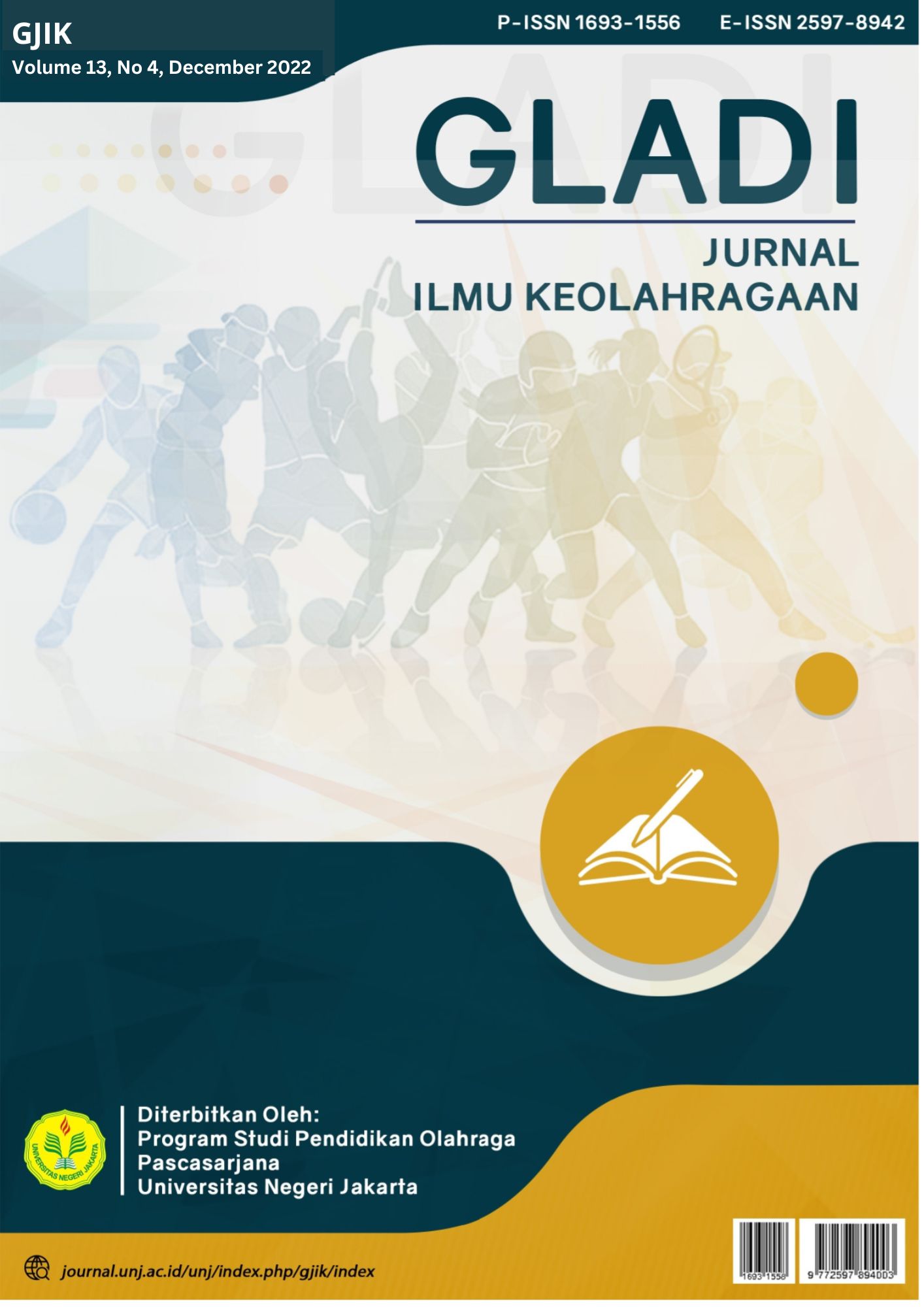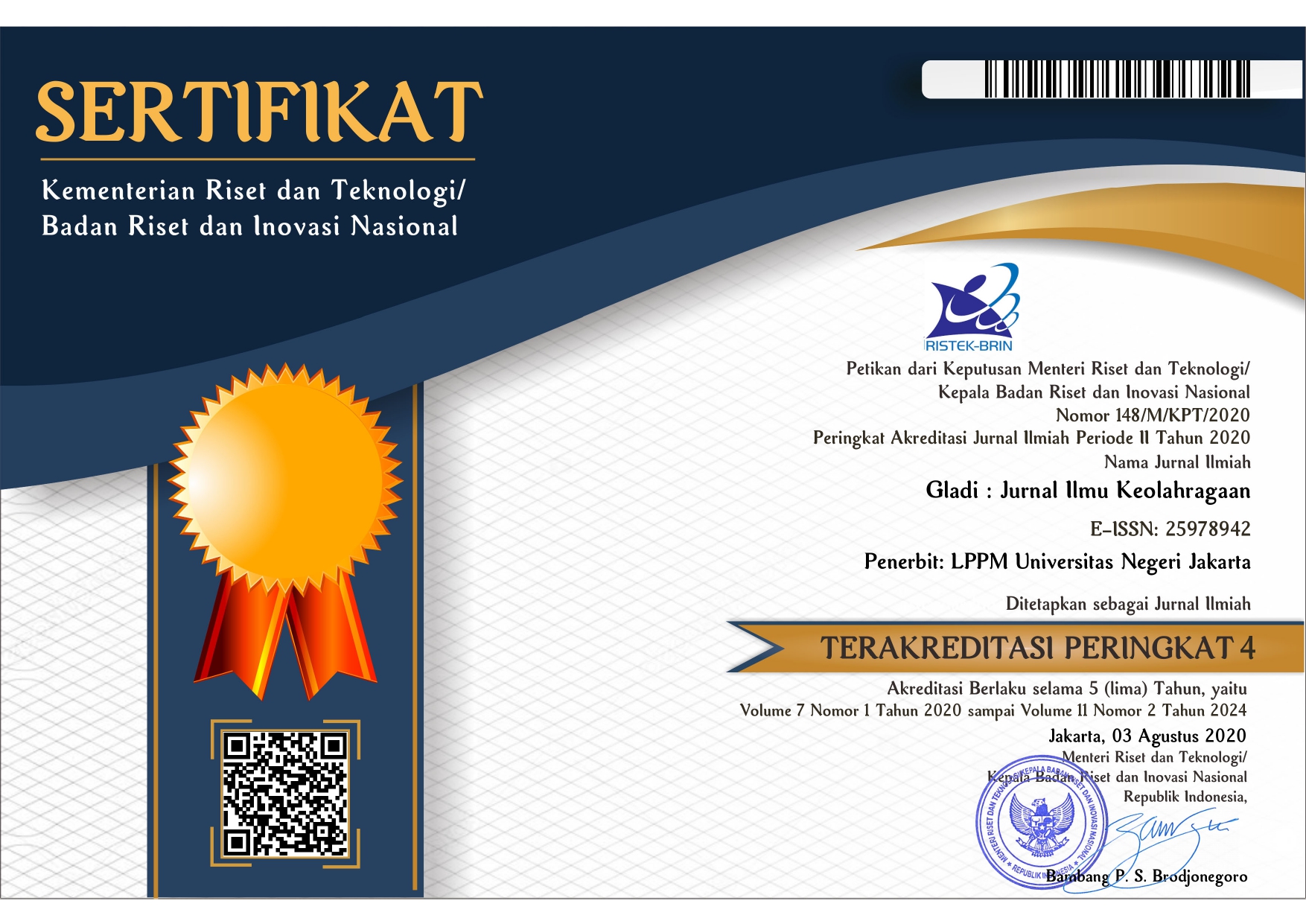The effect of eye-foot coordination, leg muscle strength and mental skills on the shooting skills of bangka football school athletes
DOI:
https://doi.org/10.21009/GJIK.134.01Keywords:
Eye-Foot Coordination, Leg Muscles, Mental Skills, ShootingAbstract
This study aims to determine the effect of eye-foot coordination, leg muscle strength, and mental skills on the shooting skills of Bangka Football School athletes. The research method used is an associative quantitative approach with non-test techniques, while the analysis technique uses a path analysis approach. This research was conducted at SSB Selindung 89, Bangka, aged 9-12 years, totaling 36 people. To measure shooting skills, use a ball shooting skill test which is placed at a point 8 m in front of the goal/target. Test your eye-foot coordination by kicking the ball against a wall or the Threebox Wall Soccer Test. Test leg muscle strength using a leg dynamometer with three trials. While the mental skills test uses a questionnaire. Conclusions from the results of the study 1) Eye-foot coordination has a direct effect on shooting skills by 34.1%. 2) Leg muscle strength has a direct effect on shooting skills by 45.3%. 3) Mental skills directly affect shooting skills by 35.4%. 4) Eye-foot coordination has a direct effect on mental skills by 23.5%. 5) Leg muscle strength has a direct effect on mental skills by 44.8%. 6) Eye-foot coordination has an indirect effect on shooting skills of athletes through mental skills of 50.7%. 7) Leg muscle strength has an indirect effect on athletes' shooting skills through mental skills of 43.8%.
Keywords: Eye-Foot Coordination, Leg Muscles, Mental Skills, Shooting
Downloads
References
Anderson, E. (2008). ‘‘I Used to Think Women Were Weak’’: Orthodox Masculinity, Gender Segregation, and Sport. Sociological Forum, 23(2), 257–280. doi:10.1111/j.1573-7861.2008.00058.x.
Antosh, R. B. (1988). Waiting for Prince Charming: Revisions and Deformations of The Cinderella Motif in Contemporary Québec Theater. Québec Studies(6), 104–111.
Beynon, J. (2002). Masculinities and Culture. Buckingham Philadelphia: Open University Press.
Chapleau, K. M. (2015). Using Masculinity to Stop Sexual Violence: Must Women Be Weak for Men to Be Strong? Sex Roles, 73, 8689. doi:10.1007/s11199-015-0498-5.
Connell, R. W. (2002). Gender. Great Britain: Polity.
Djungdjung, J. M. (2009). Membaca Ideologi Gender dalam Chick lit Inggris dan Indonesia. (Disertasi), Universitas Indonesia, Depok.
Dobson, E. (2017). Sleeping Beauties: Mummies and the Fairy-Tale Genre at the Fin de Siècle. Journal of International Women's Studies, 18(3), 19–34.
Dowling, C. (1981). The Cinderella Complex: Women’s Hidden Fear of Independence. New York: Pocket Books.
Dreamer, L. (Ed.) (2010) Urban Dictionary. https://www.urbandictionary.com/define.php?term=Dreamer.
Fakih, M. (2012). Analisis Gender dan Transformasi Sosial. Yogyakarta: Pustaka Pelajar.
Feasey, R. (2008). Masculinity and Popular Television. Edinburgh: Edinburgh University Press.
Goodreads. (2010). Sleepaholic Jatuh Cinta. Goodreads. https://www.goodreads.com/book/show/9097556-sleepaholic-jatuh-cinta.
Humm, M. (2007). Ensiklopedia Feminisme (M. Rahayu, Trans.). Yogyakarta: Fajar Pustaka Baru.
Intan, T. (2020). Stereotip Gender dalam Novel Malik & Elsa Karya Boy Candra. Jurnal Bindo Sastra, 4(2), 85–94.
Ismah, N. (2020). Reading Indonesian and Malaysian Young Adults Novels: Capturing The Image of Young Muslim Women in Indonesia and Malaysia. Humanisma: Journal of Gender Studies, 4(2), 108–121.
La Rochère, M. H. D. d. (2010). "But marriage itself is no party": Angela Carter's Translation of Charles Perrault's "La Belle au bois dormant"; or, Pitting the Politics of Experience against the Sleeping Beauty Myth. Marvels & Tales: Journal of Fairy-Tale Studies, 24(1), 131–151.
Mahendra, I. (2017). Stereotip Gender dan Penyebaran Wacana Maskulinitas dalam Novel Balada Si Roy: Joe Karya Gola Gong. Alayasastra, 13(2), 105–118.
Milestone, K. M., A. (2012). Gender and Popular Culture. Great Britain: MPG Books Group.
Modleski, T. (2008). Loving with a vengeance: mass-produced fantasies for women. New York: Routledge.
Moleong, L. J. (2012). Metode Penelitian Kualitatif. Bandung: Remaja Rosdakarya.
Nazir, Moh. (1988). Metode Penelitian. Jakarta: Ghalia Ind.
Ningrum, T. U. (2016). Inferioritas Perempuan dalam Novel Cantik Itu Luka Karya Eka Kurniawan. (Skripsi), Universitas Nusantara PGRI, Kediri.
Nurfaidah, R. (2020). Elsa dalam Cengkeraman Disney. Sirok Bastra, 8(2), 159–176.
Patel, H. (tanpa tahun). Gender Roles Indoctrinated Through Fairy Tales in Western Civilization. (Tesis), Swamy Shreeji II.
Pearce, L. S., J. (1995). Romance revisited. London: Lawrence and Wishart.
Pequinot, B. (1991). La relation amoureuse: analyse sociologique du roman sentimental modern. Paris: L’Harmattan.
Perdana, D. D. (2014). Stereotip Gender dalam Film "Anna Karenina". Jurnal Interaksi, 3(2), 123–130.
Priyatna, A. (2018). Kajian Budaya Feminis Tubuh, Sastra, dan Budaya Pop. Yogyakarta: Arti Bumi Intaran.
Putri, A. W. (2017). Jadi Putri Tidur Gara-gara Sindrom Kleine-Levin. Tirto.id. https://tirto.id/jadi-putri-tidur-gara-gara-sindrom-kleine-levin-cyZk.
Radway, J. A. (2006). Reading the romance: women, patriarchy, and popular literature; with a new introduction by the author. Chapel Hill [u.a.]: Univ. of North Carolina Pr.
Rozario, R.-A. C. D. (2010). The Princess and the Magic Kingdom: Beyond Nostalgia, the Function of the Disney Princess. Women's Studies in Communication, 27(1), 34–59. doi:http://dx.doi.org/10.1080/07491409.2004.10162465.
Sari, D. N. (2010). Konstruksi Gender dalam Film Indonesia (Konstruksi Relasi Gender dalam Film "Perempuan Berkalung Sorban"). CommLine, 1, 171–188.
Seifert, L. C. (2015). Queer Time in Charles Perrault’s “Sleeping Beauty”. Marvels & Tales: Journal of Fairy-Tale Studies, 29(1), 21-41.
Semi, M. A. (2012). Metode Penelitian Sastra. Bandung: Angkasa Jaya.
Subekti, M., Gumilar, T. (2017). Konstruksi Lelaki dalam Chick lit The Hopeless Romantic’s Handbook dan Cintapuccino. Suar Bétang, 12(1), 93–101.
Suhendi, D. (2008). Inferioritas Perempuan dalam Perkawinan: Kajian Hermeneutika dan Kritik Sastra Feminis dalam Novel Azab dan Sengsara. 1–20.
Sunarto. (2010). Stereotipasi Peran Gender Wanita dalam Program Televisi Anak di Indonesia. Jurnal Ilmu Komunikasi, 8, 233–245.
Zeng, A. (2010). Sleepaholic Jatuh Cinta. Jakarta: PT Gramedia Pustaka Utama.







